The Chang’e-5 spacecraft has landed in the Mons Rümker region of the moon’s northern Oceanus Procellarum. It has returned 1.731 kg of lunar regolith.
Recognizing exotic clasts in Chang’e-5 regolith could provide critical information about the moon’s lithological diversity and regolith gardening process.
Dr. Zeng Xiaojia, Prof. Li Xiongyao, and Prof. Liu Jianzhong of the Chinese Academy of Sciences’ Institute of Geochemistry (IGCAS) recently identified seven exotic igneous clasts in Chang’e-5 samples from over 3,000 Chang’e-5 regolith particles.
On December 22, this work was published in Nature Astronomy.
The seven exotic clasts identified are as follows:
- A vitrophyric fragment rich in Ti
- Basalt with low Ti content
- An olivine-pyroxenite mixture
- Anorthosite magnesian
- A developed lithology
- Olivine fragment rich in Mg
- A bead of pyroclastic glass
These unusual igneous clasts were linked to impact-ejected materials from other regions of the moon. It was 50-400 kilometres away from the Chang’e-5 mare unit.
The researchers discovered that three exotic igneous clasts in the Chang’e-5 regolith exhibited unusual petrological and compositional features when compared to lunar rocks from the US Apollo mission.
The high-Ti vitrophyric fragment displayed unusual mineralogy among lunar basalts. It implied that it is a new type of lunar basalt.
The magnesian anorthosite clast was not found in Apollo samples. But now it indicates that magnesian anorthosite is a component of the near-side lunar crust.
The pyroclastic glass records a compositionally unique lunar volcanic eruption.
This was the first study to obtain exotic igneous lithologies from the moon’s 2 Gyr-aged basalt unit. This data will serve as ground truth for modelling the origin of regolith at the moon’s young mare unit.
The discovery of unusual lunar rocks in the Chang’e-5 sample suggests that the lunar crust’s lithological components and magmatic activities are more diverse than previously thought.
This study suggests that there are still undiscovered geological units on the moon. It could aid in the planning of future lunar exploration missions.
More information: Xiaojia Zeng et al, Exotic clasts in Chang’e-5 regolith indicative of unexplored terrane on the Moon, Nature Astronomy (2022). DOI: 10.1038/s41550-022-01840-7

